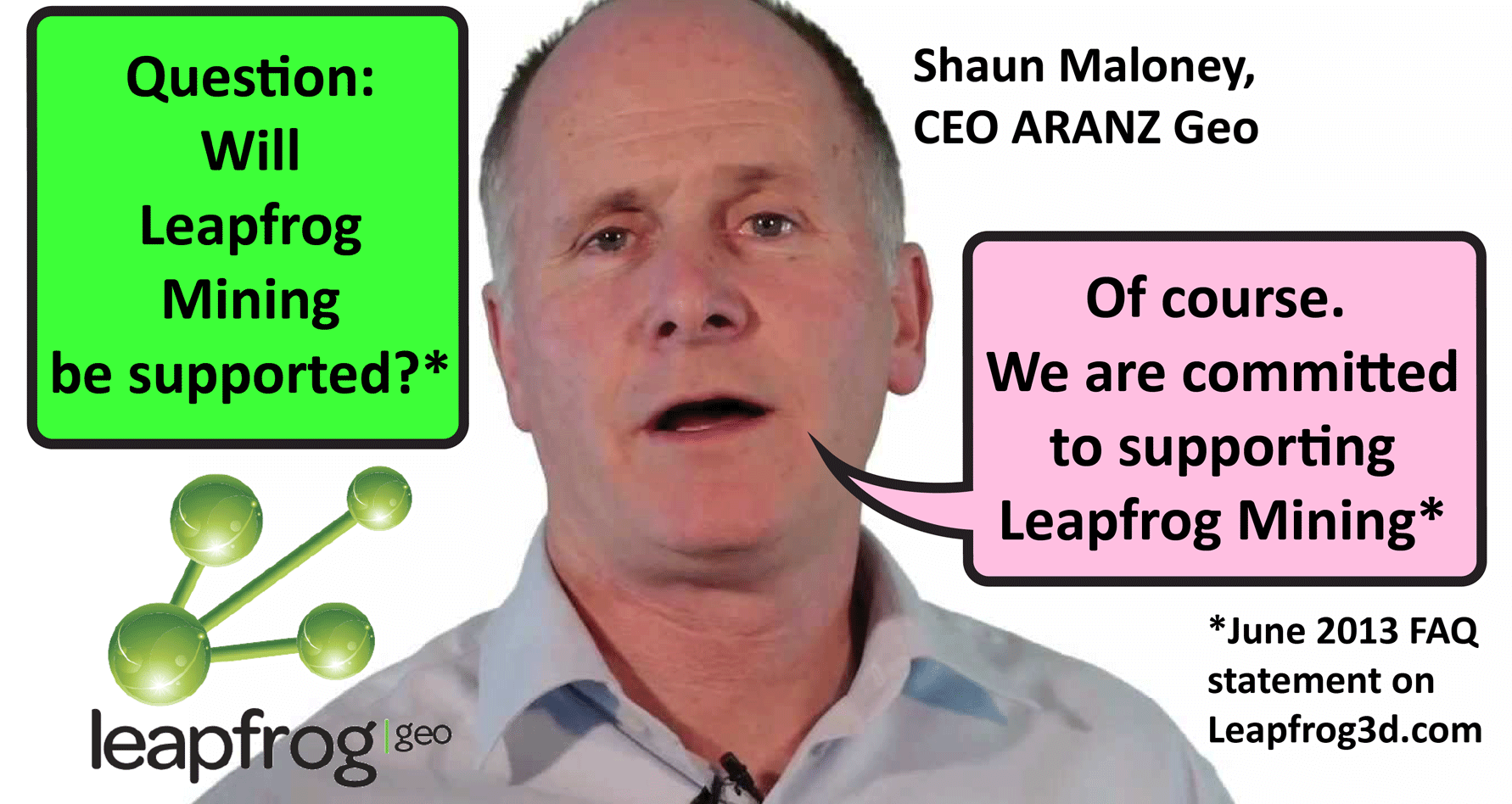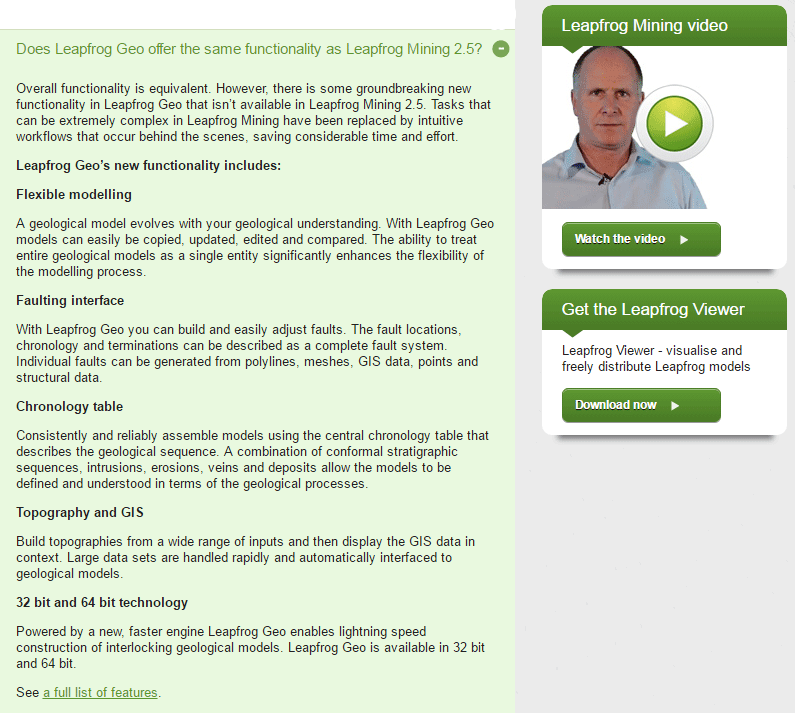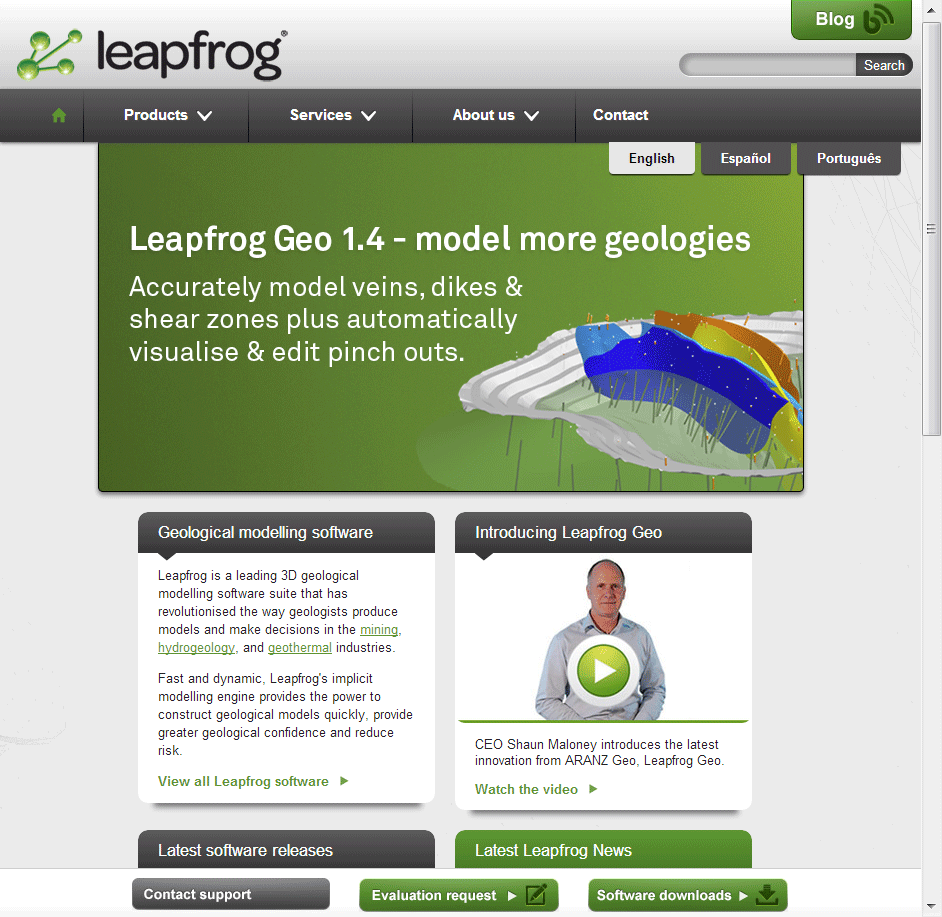
Leapfrog Geo first hit the market in February 2013 with much fanfare and celebration, marketed as the next evolution of Leapfrog—an advancement on the now renamed toolbox of Leapfrog Mining. People were after a workflow approach to building geological models we were told and this new product provided that, it could accomplish most of what Leapfrog Mining could (Figure 1), and what it could not accomplish would be rapidly built into the new software. Everyone from the top down in ARANZ told the world that Leapfrog Mining would not be decommissioned until that time as Leapfrog Geo could do all that Leapfrog Mining could and until all long time mining users (many of whom had been using mining for 10 years) would be happy to move across (ARANZ Geo, 2013a).
 Figure 1. ARANZ Geo FAQ in June 2013 explains how Leapfrog Geo has “equivalent functionality” but with “ground breaking new functionality” that isn’t available in Leapfrog Mining (ARANZ Geo, 2013a). As it turns out, Leapfrog Geo was rushed and unusable in its first release, and the ground breaking new functionalities were anything but critical to the geological modelling process Leapfrog Mining users have been used to.
Figure 1. ARANZ Geo FAQ in June 2013 explains how Leapfrog Geo has “equivalent functionality” but with “ground breaking new functionality” that isn’t available in Leapfrog Mining (ARANZ Geo, 2013a). As it turns out, Leapfrog Geo was rushed and unusable in its first release, and the ground breaking new functionalities were anything but critical to the geological modelling process Leapfrog Mining users have been used to.
Leapfrog Mining, released on December 2003, was a huge leap forward in geological modelling and required the user to start to think differently to the old 2D sections / 3D wireframe approach. In fact if you attempted to model this way in Leapfrog you very quickly came unstuck, but it was not a black box, it required a lot of thought, manipulation and geological knowledge to achieve a result that was useable. The most common use—and frankly a very poor use of the software abilities—was to create a grade shell, export it to a standard GMP where the wireframe was sliced and re-digitised in 2D sections and re-wireframed. This is still done—in fact an online search of current NI43-101 reports will show up many instances where this is still done. The other very common use was as a simple display program to throw things up on the projector in the boardroom—a nice 3D presentation program (shades of FracSIS here methinks). It was into this sort of market that Leapfrog Geo was released and a vast majority of today's users actually have never seen, nor have any idea as to the power of Leapfrog Mining. When Leapfrog Geo was first released it promised much but actually delivered and accomplished very little, it was a very pale shadow of its decade older sibling.
Now anyone who has made the transition will know that the work involved is monumental, nothing sits where it is supposed to, most of the settings have been moved under the bonnet so that the user can no longer assess, manipulate or otherwise interact with them and the whole workflow approach, whilst probably great for a simple stratigraphic model (rare situation in a mineral deposit) is actually a real pain when it comes to modelling mineralisation and ore deposits. This is a significant hurdle for advanced users as they often tweak and adjust all these under the bonnet settings to accomplish a desirable result, something they can no longer do. The major difference between the programs is the shift from modelling in 3D space and volumes (Leapfrog Mining) to modelling solid meshes and trying to get them to interact to accomplish a task (Leapfrog Geo), this is almost a step backwards from the ground breaking methodology of Leapfrog Mining to something more akin to business as usual. The backward-ness or unwinding of Leapfrog’s ability in Leapfrog Geo is most easily seen by counting mouse clicks to accomplish a task. In most cases the number of mouse clicks required to accomplish a task in Leapfrog Mining is far less than that required for the same in Leapfrog Geo—an effective reduction in productivity and can hardly be called "moving forward", or as ARANZ Geo referred to as “ground breaking” (ARANZ Geo, 2013a).
Leapfrog Mining was quietly withdrawn from Market over a year ago in 2015, and this week's challenge for anyone reading this is to find it on the Leapfrog3D website...We have had no announcement that Geo is now as versatile, powerful and useful as Leapfrog Mining; so is it?
The short answer is “No”
Those of you who have been following my blog posts about Leapfrog Geology modelling software on Orefind.com—on both the original Leapfrog (now called Leapfrog Mining) and Leapfrog Geo flavours, will know that last year I wrote a post titled "Five things about Leapfrog Geo that mean I will continue to use Leapfrog Mining". With the release of v3.1 - effectively the 3rd release since I wrote the blog post mentioned above; has anything been done that addresses these five basic issues?
To recap they where:
- A default disk and ribbon size based on the project extents rather than on something more sensible such as based on the screen extents.
- The destruction of the versatility of the Moving Plane by changing it from a plane fixed to screen coordinates to one fixed to world coordinates. This basically means that whereas in mining you can shift the moving plane very easily across the screen to one that requires many adjustments to the X,Y and Z handles to shift it—you do not always want to just "redraw it" as you may be comparing different strikes/plunges of mineralised components and want to maintain the plane orientation.
- The loss of combined interpolants—this was a great way mixing various grade interpolants to approximate the in ground value and see how the ore body behaves. This is no longer possible in Geo (no we are not talking the simple "Combine Models" available in Geo which is just a simple Boolean process).
- The loss of the very simple but highly effective Leapfrog Mining 3D polyline tool, and the introduction of, wait for it, not one, but FOUR separate tools as a replacement—the GIS tool; the (straight) polyline tool; the structural disks tool (for points); and the curved polyline tool. None of these are as effective or useful as the original Leapfrog’s 3D polyline tool with which you could accomplish "straight" segmented lines (straight polyline tool); curved Bezier lines (curved polyline tool); digitise along wireframes (GIS tool) and add in individual points (you now have to utilise the structural disks tool - which is effectively a mismanagement of this tool). One can hardly claim this as going forward or an improvement.
- The loss of the ability to query interpolants and build domains. This would have to be the one biggest draw back in Leapfrog Geo and the one thing used all the time in Leapfrog Mining. Imagine if you will, you are in the boardroom with seagulls from near and far assessing the merits of the current project. CEO Seagull turns to you and says "Can you show us where the high gold / low copper grades in the oxidised porphyry sit; we want to get a handle on how it might be approached from a mining perspective whilst we have access to our hot shot mining engineer consultant here today?" Now in Leapfrog Mining you could simply reply in the affirmative, create a new domain and write a query that looks for "Porphyry > 0 AND oxide > 0 AND Gold > 1g/t AND Copper < 0.2%", watch it process and throw the resultant wireframe up on screen, < 2 minutes to completion, question answered, Chief Seagull happy, a very simple process. In Leapfrog Geo you look Chief Seagull in the eyes and say "Sorry sir but now that we have migrated to Leapfrog Geo we can no longer easily do this, as the person responsible for this decision I shall tender my resignation this afternoon!".
- There was a 6th thing—the replacing of the save scene button in Leapfrog Mining with the discard all button—now there was a decision I am sure was deliberately designed around ensuring Leapfrog Mining users would be ready to kill (personal experience with said CEO in Boardroom)!
This is not the whole list, very useful (indeed essential) tools that were (and are) left out of Leapfrog Geo included form surfaces; the ability to generate a true medial plane; the removal of the ability to import special values—requiring you to re-enter these for every new drillhole database created; the loss of the ability to do various window filters; the separation of the LF server from the front-end program; to name just a few.
So in the nigh on year and a half and 3 releases later what has changed? Well, the save scene button is back although you have to manually activate it in the User interface tab—something I do without fail. Apart from that—nothing (Figure 2)! Table 1 lists these and shows what has been achieved over the last 3 years.

Figure 2. ARANZ Geo in October 2013 enthusiastically announces that their upcoming new release Leapfrog Geo 1.4 can model “more geologies” [sic], with CEO Shaun Maloney making a video announcement in a new release video (ARANZ Geo, 2013b). Their “innovative” Leapfrog Geo 1.4 turns failed to measure up to the nearly the decade old Leapfrog Mining. Table 1. So what has been done to address these deficiencies... 
In the interests of full disclosure I do have it on good authority that the polyline tool is in for a major upgrade (point 4 above) and the missing form surfaces option will make an appearance at some time. As for the rest—nothing on the near horizon. It is a shame that a magnificent piece of software like Leapfrog Mining was abandoned for a program that can only do half the things Leapfrog Mining could. Sure Leapfrog Geo can do a lot that Leapfrog Mining could not do—a lot of the drill hole database tools for instance; the block modelling tools and big improvements in speed of processing are great but these were interesting additions masking the loss of major functionality of Leapfrog Mining and are certainly not ground breaking. Unfortunately these are very useful functionality that most users have no idea even existed. You could build the same geological models in Leapfrog Mining that you can in Leapfrog Geo—but you cannot accomplish half the tasks I do on a day to day basis with Leapfrog Geo that I can do in Leapfrog Mining.
Have promises been broken?
Yes, Leapfrog Geo does not have the same tools, nor can it accomplish everything Leapfrog Mining did, as was promised by the company and CEO who said this would be achieved prior to decommissioning Leapfrog Mining (Figure 3).
Figure 3. ARANZ Geo in June 2013 states “Of course. We are committed to supporting Leapfrog Mining...” (ARANZ Geo, 2013a). This message was reiterated, personally in a video, by the CEO of ARANZ Geo, Shaun Maloney.
Is discontinuing Leapfrog Mining a year ago in 2015, before Leapfrog Geo is anywhere up to standard of Leapfrog Mining, count as being supportive?
In addition, many of ARANZ Geo competitors are rapidly closing the gap on Leapfrog Geo—a program that has been left unfinished while ARANZ Geo ran off chasing new dreams (eg.
Leapfrog Aspect and
Leapfrog Central which are both sleep inducing to Leapfrog Mining users, and hardly what one would call innovative).
The only unique thing Leapfrog Geo has in its stable over every one else, at the moment, is FastRBF but with the rapid pace of computer evolution many of the competitors now have algorithms that are reeling in this advantage. The use of Geological "workflow" is not unique to Leapfrog Geo and some of its competitors have better implementations of it that existed before ARANZ introduced it to Leapfrog Geo. At the rate ARANZ Geo is trying to reinvent the wheel, it will not be long before Leapfrog Geo is just another software package and the years of Leapfrog being a revolutionary and ground breaking program will be all but gone.
This would be a shame and ARANZ Geo can make the program ground breaking again by giving us the tools that Leapfrog Mining had and no one else does. Focus and finish the product properly first, and then move on to the bigger and better dreams. The funny thing is, Leapfrog has a huge untapped unrealised potential yet to be implemented into effective design, and it will likely be the biggest thing ARANZ Geo will ever work on. It’s just a shame that ARANZ Geo themselves do not realise this opportunity—because an opportunity to have completely changed the mining industry is slowly slipping away before their eyes.
We continue to live in hope that Leapfrog Geo at least catches up to Leapfrog Mining one day, faltering and failing as our hope may be…
Happy Modelling!
Ron Reid, is a resource geologist for Harmony Gold in Brisbane, and has been contributing posts for Orefind's blog for the last several years. This post, and many more like this, can be found at www.orefind.com/blog.
References:
ARANZ Geo, 2013a, Leapfrog website, Leapfrog Mining FAQ. www.leapfrog3d.com/products/leapfrog-mining/faqs. [Accessed 8 June, 2013].
ARANZ Geo, 2013b, Leapfrog website, home page. www.leapfrog3d.com/. [Accessed 5 October, 2013].